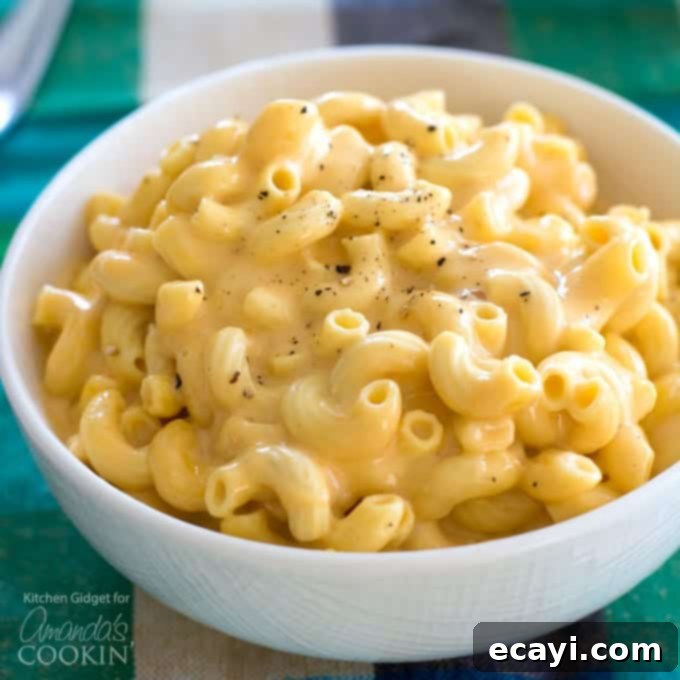Creamy No-Boil Slow Cooker Mac and Cheese: The Ultimate Easy Recipe for Perfect Indulgence
Imagine a rich, creamy mac and cheese that practically makes itself, freeing you from the stovetop and oven. This incredible slow cooker mac and cheese recipe starts with uncooked elbow pasta, meaning absolutely no prior boiling is required. Simply combine whole milk, evaporated milk, a selection of delicious cheeses, and a blend of savory seasonings in your slow cooker, and let the magic happen. The result is a comforting, cheesy dish that’s sure to be a hit with everyone at your table, whether for a weeknight dinner or a special gathering.
Using a slow cooker for macaroni and cheese offers unparalleled convenience and consistent results. Not only is your appliance super portable, making this dish ideal for potlucks, family get-togethers, or holiday meals, but the slow cooking method also ensures your mac and cheese stays wonderfully moist and creamy without drying out. This recipe simplifies a classic comfort food, delivering a truly effortless and deeply satisfying culinary experience without the constant stirring or oven monitoring.
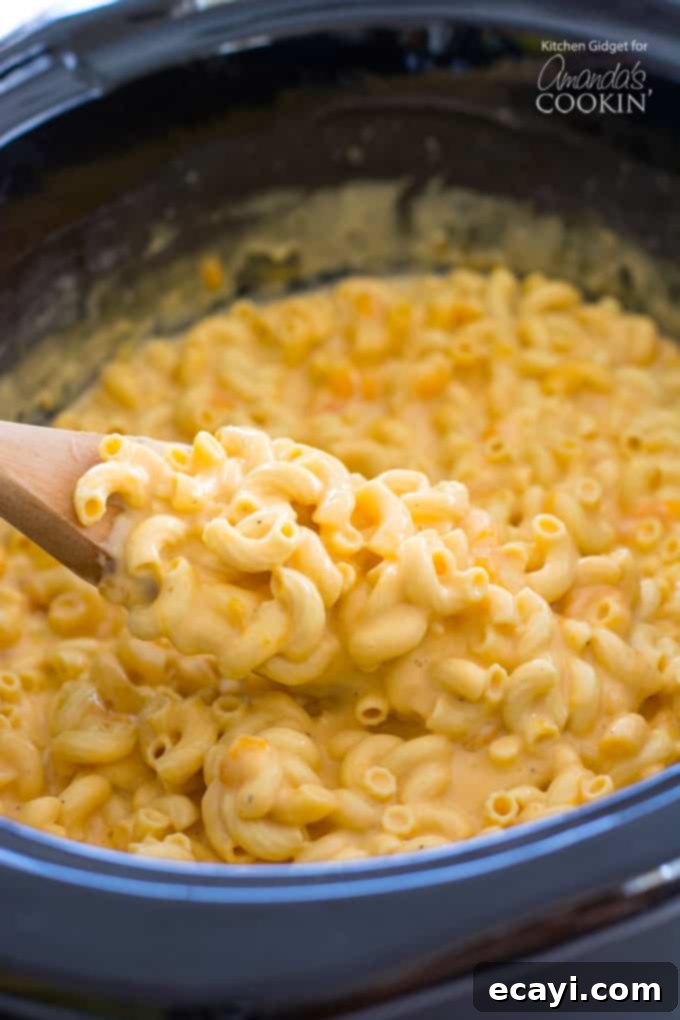
The Irresistible Appeal of Slow Cooker Mac and Cheese
Macaroni and cheese holds a special place in the hearts of many, a quintessential comfort food beloved across generations. While there are numerous ways to prepare this cherished dish, from traditional baked casseroles to creamy stovetop versions, the slow cooker method stands out for its sheer convenience and consistent results. Unlike baked mac and cheese, which often incorporates eggs for structure and results in a casserole-like texture, or stovetop béchamel-based recipes known for their silky smoothness, our slow cooker approach offers a unique blend of ease and exquisite creaminess that can’t be beaten.
The beauty of the slow cooker lies in its ability to gently cook ingredients over an extended period at a low, steady temperature. This consistent, indirect heat is perfect for pasta, allowing it to absorb the creamy sauce without becoming overly mushy, provided you follow a few key tips. It also means you can largely set it and forget it, freeing up your time to focus on other tasks or simply relax. For busy weeknights or large gatherings where oven space is at a premium, this “hands-off” aspect is invaluable. Plus, the slow cooker doubles as a serving vessel, keeping the mac and cheese warm and melty for hours.
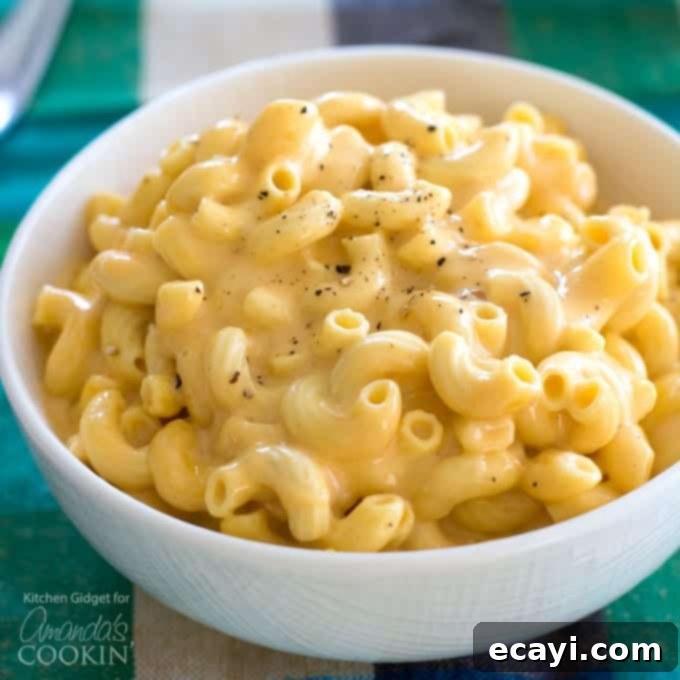
Achieving Unrivaled Creaminess: The Secret Behind the Sauce
The quest for an ultra-creamy mac and cheese in a slow cooker often leads to suggestions of using condensed cheese soup or processed cheese products like Velveeta. While these can deliver a certain level of creaminess, they frequently introduce an artificial flavor profile that many prefer to avoid. Our recipe achieves that luxurious, smooth texture using a thoughtful combination of natural dairy products and carefully selected cheeses, ensuring a superior taste and satisfying mouthfeel without compromise.
The absolute key to this recipe’s exceptional creaminess lies in the use of evaporated milk. Unlike regular milk, evaporated milk has much of its water content removed through a heating process, resulting in a naturally thicker, richer, and slightly caramelized base. This concentrated milk contributes significantly to the sauce’s luscious consistency and depth of flavor. When combined with whole milk, it creates a perfect balance that coats the pasta beautifully as it cooks slowly. For the cheese component, choosing varieties known for their superior meltability is crucial. While deli-sliced American cheese (not individually wrapped processed slices) is an excellent choice for its incredibly smooth melting properties, other options like Muenster or Havarti will also yield wonderfully creamy results due to their high moisture and fat content. Sharp cheddar adds the essential tangy “mac and cheese” flavor that we all love, but a critical tip for avoiding a gritty texture is to always buy cheddar in block form and shred it yourself. Pre-shredded varieties often contain anti-caking agents that don’t always fully dissolve, leaving an unpleasant grainy feel in your finished dish.
Essential Prep for Holiday Feasts
Planning to serve this delicious slow cooker mac and cheese for a special occasion like Thanksgiving, Christmas, or any holiday gathering? A little preparation goes a long way to ensure perfection. If you’ve never made this recipe before, we strongly recommend doing a “dry run” a week or two before the actual holiday. Slow cookers can vary significantly in how they heat and cook, even on the same low settings. Practicing beforehand allows you to understand your specific appliance’s nuances, ensuring perfect results when it matters most. This also gives you an opportunity to test and adjust the seasonings to your personal preference. Please also take a moment to read through our comprehensive Frequently Asked Questions (FAQ) section below for additional insights and troubleshooting tips specific to slow cooker mac and cheese.
Frequently Asked Questions About Slow Cooker Mac and Cheese
Over time, we’ve received many common questions about this popular and beloved recipe. To help you achieve the best possible results and avoid any potential pitfalls, we’ve compiled a list of frequently asked questions and their detailed answers. Please review this section thoroughly before starting your preparation, as your query might already be addressed here. Additionally, always refer to the specific notes provided within the printable recipe card for crucial details and last-minute reminders.
Can I double this recipe, and will it affect the cooking time?
Yes, this slow cooker mac and cheese recipe can absolutely be doubled, provided you have a large enough slow cooker to accommodate the increased volume of ingredients. Most 6-quart or larger slow cookers can handle a double batch, but make sure the pasta and sauce mixture doesn’t fill the pot beyond the two-thirds mark. This is important to prevent overflow during cooking and to ensure even heat distribution, which is key for proper pasta doneness. Interestingly, doubling the recipe typically does not significantly change the cooking time. The larger mass of ingredients will naturally take longer to come up to temperature initially, but once heated, the cooking process for the pasta remains relatively consistent. However, it’s always wise to start checking for doneness at the usual suggested time (around the 1-hour mark) and continue monitoring every 15-30 minutes as needed, rather than blindly following the original timing.
I prefer white cheese; what are good substitutes for yellow cheese?
If you prefer white cheese for aesthetic reasons or simply enjoy different flavor profiles, you have several excellent options that will still deliver fantastic flavor and creaminess to your slow cooker mac and cheese. Muenster cheese is a wonderful choice due to its incredibly smooth melting properties and mild, buttery taste. White American cheese, when purchased from the deli counter (again, avoid processed singles), is another superb alternative, offering the same melt-factor and creamy consistency as its yellow counterpart. For those who crave a sharper, more complex flavor, White Cheddar, especially a high-quality Vermont white sharp cheddar, will provide a robust and distinctive taste that many mac and cheese enthusiasts adore. A marble cheese, which combines white and yellow cheddar, could also work well if you’re open to a subtle hint of color. Remember, for the best and smoothest texture, always shred your cheese from a solid block rather than relying on pre-bagged shredded varieties.
Can I make this ahead of time and reheat it?
While technically possible, we generally do not recommend fully reheating macaroni and cheese, especially a slow cooker version made with uncooked pasta. Mac and cheese, particularly when the pasta cooks directly in the sauce, tends to lose its optimal texture upon reheating. The pasta can absorb too much liquid, becoming mushy or swollen, and the sauce may separate, become overly thick, or develop an undesirable grainy texture. If making ahead is absolutely necessary, such as for transporting to a potluck, prepare it just before you need to leave. Once it’s fully cooked in the slow cooker, turn off the appliance but leave the lid securely on to keep it warm. Upon arrival at your destination, give it a good stir. If the sauce has thickened too much during holding, you can add a splash of warm milk (whole milk or evaporated milk works best) and stir gently until it reaches your desired consistency. This method helps to “loosen” the sauce without full reheating, thereby preserving the pasta’s texture much better.
Why was my mac and cheese gritty?
A gritty texture in mac and cheese is a common and highly frustrating issue, and it’s almost always attributable to one primary culprit: pre-packaged shredded cheese. These convenience cheeses contain anti-caking agents, such as cellulose powder, cornstarch, or potato starch, which are designed to prevent the shreds from clumping together in the bag. Unfortunately, these agents don’t always fully dissolve into the sauce during the cooking process, leaving behind a discernible, gritty residue that ruins the smooth mouthfeel. To avoid this unpleasant texture, we emphatically recommend purchasing blocks of cheese from the deli counter or dairy aisle and shredding them yourself, either by hand with a box grater or efficiently using a food processor. This ensures a pure, smooth melt every time. We’ve also observed that some less expensive cheese brands, even when shredded from a block, can occasionally produce a slightly gritty result immediately after cooking, but this grittiness often dissipates if the mac and cheese is allowed to sit for a short period before serving.
Why was my mac and cheese mushy?
Mushy macaroni is another frequent complaint from slow cooker mac and cheese makers, and it typically stems from either overcooking or using the wrong type of pasta.
- Cooking Time and Temperature: If your mac and cheese cooks too fast or for too long, the pasta will inevitably become mushy. It’s crucial to understand that slow cookers vary significantly in temperature, even on the “low” setting. Older models, in particular, can sometimes run hotter than newer ones, which cook more efficiently. It’s paramount to resist the urge to increase the temperature setting to “High,” as this will almost certainly lead to rapid overcooking and mushy pasta. Instead, cook on low for the initial hour with the lid on, without peeking. After this first hour, remove the lid quickly and stir. Then, replace the lid and continue cooking, checking for doneness and stirring gently every 15-30 minutes. Our slow cooker typically finishes in about 1 hour and 45 minutes, but yours may take anywhere from 1.5 to 3 hours.
- Pasta Type: The thickness and structure of your macaroni noodles play a monumental role in preventing mushiness. Thin macaroni noodles are the biggest culprit here. We strongly recommend using a sturdy, thicker brand of elbow pasta, such as Barilla or Creamette, which often feature ridges or a robust wall thickness that helps them hold their shape better and cook evenly during the slow cooking process. Thinner noodles, on the other hand, will absorb liquid much more rapidly and are highly prone to turning to mush.
- Gluten-Free Pasta: If you’re opting for gluten-free macaroni noodles, exercise extra caution. Gluten-free pastas generally do not hold up as well under extended cooking times compared to traditional wheat pasta and can become mushy very quickly. One reader successfully made this recipe with gluten-free pasta, noting it was perfectly done in 90 minutes but started to become mushy at the 2-hour mark. Close monitoring and possibly reducing total cooking time are essential when using gluten-free alternatives.
Can I mix all the ingredients, refrigerate overnight, and put them in the crockpot a few hours prior to serving?
You can certainly prepare many of the ingredients in advance for this recipe, which can be a great time-saver, especially for busy days or holiday meal prep. For example, you can shred all your cheeses, measure out your milks, and combine all the dry seasonings (salt, pepper, mustard, garlic, cayenne) the night before. Store these prepared components separately and covered in the refrigerator. However, there’s one critical exception to this make-ahead strategy: the pasta itself. Do not add the uncooked macaroni noodles to the liquid and cheese mixture and refrigerate it overnight. The pasta will immediately begin to absorb the liquid and swell, resulting in a soggy, mushy texture even before it starts cooking in the slow cooker. This premature absorption will lead to an undesirable final product. Instead, prepare all other ingredients and store them separately. Wait until you are ready to turn on your slow cooker and begin the cooking process before you add the uncooked macaroni noodles to the pot.
I’m confused by the cooking time; is it 2 hours or 3?
The cooking time for this slow cooker mac and cheese is indeed presented as a range, typically up to 3 hours on the low setting. This variability is not a mistake but rather due to the inherent differences in slow cooker models. Just like conventional ovens, slow cookers can heat differently; some run hotter or cooler than others, even when set to the same temperature (e.g., “Low”). For this reason, a precise, universal cooking time is difficult to provide. For best results, we recommend cooking the dish on low for an initial 1 hour without opening the lid. After this initial hour, carefully remove the lid, stir the mixture thoroughly, and check the pasta’s tenderness and the sauce’s consistency. From that point onward, continue cooking and check the mac and cheese periodically—approximately every thirty minutes or so—until the pasta is perfectly tender and the sauce is thick, creamy, and coats the macaroni beautifully. The “up to 3 hours” instruction allows for this necessary flexibility and active monitoring, ensuring you achieve ideal results regardless of your specific slow cooker’s performance.
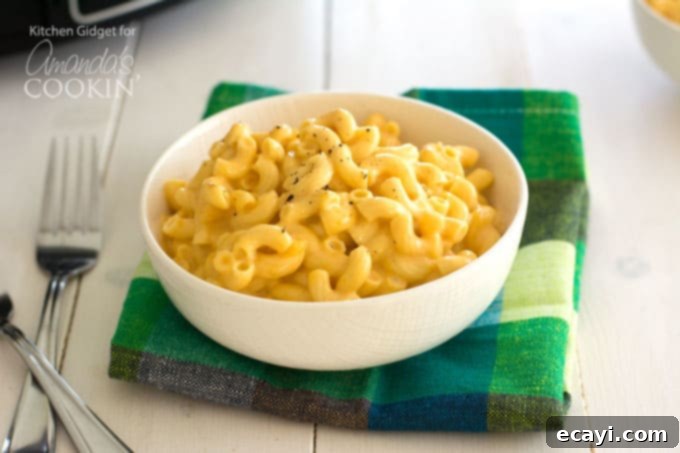
Flavor Enhancements for Your Ultimate Mac and Cheese
While cheese and milk form the foundation of this classic comfort dish, a thoughtful blend of seasonings elevates it from simply good to truly exceptional. To prevent our slow cooker mac and cheese from tasting bland or one-note, we incorporate a subtle yet impactful combination of dry mustard, garlic powder, and a dash of cayenne pepper, in addition to the essential salt and black pepper. Dry mustard, often overlooked, is a culinary secret weapon that enhances the natural cheesy flavor without imparting a distinct mustard taste. Garlic powder adds a layer of savory depth and warmth, while a hint of cayenne pepper provides a gentle warmth and subtle kick, beautifully balancing the richness of the cheese. These suggested seasonings are merely a starting point and can (and should!) be adjusted to suit your personal taste preferences. Feel free to experiment with other additions like a pinch of onion powder for more savory notes, a touch of smoked paprika for a smoky undertone, or even a tiny grating of fresh nutmeg for a sophisticated touch, which often complements cheese sauces beautifully. Don’t be afraid to make it your own!
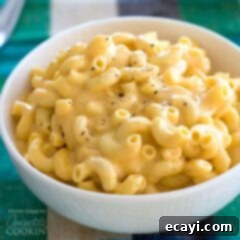
Crockpot Mac and Cheese Recipe Card
IMPORTANT – There are often Frequently Asked Questions within the blog post that you may find helpful. Simply scroll back up to read them!
Print It
Pin It
Rate It
Save ItSaved!
Ingredients
- 1 pound elbow pasta uncooked (regular, NOT gluten-free, NOT quick-cook pasta; we recommend Barilla brand for its sturdy quality)
- 2 ½ cups whole milk
- 12 ounces evaporated milk
- 12 ounces Extra sharp cheddar (about 3 cups shredded; purchase from the deli counter and shred yourself, do NOT buy pre-bagged)
- 4 ounces American cheese (about 1 cup shredded; from the deli counter, not individually wrapped processed slices)
- 1 teaspoon salt
- ½ teaspoon black pepper
- ½ teaspoon dry mustard
- ¼ teaspoon garlic powder
- Dash of cayenne pepper to taste, for a subtle kick
- ¼ cup unsalted butter cubed, for extra richness
Essential Equipment
-
5-6 quart Slow Cooker
-
Food processor or a box grater for shredding cheese
-
Liquid measuring cup
-
Standard measuring cups and spoons
Important Notes & Expert Tips for Success
- Cheese Selection is Key: For the ultimate creamy, smooth texture, avoid using pre-bagged shredded cheese. These often contain anti-caking agents (like cellulose or starches) that can lead to a gritty or clumpy sauce. Always purchase cheese in solid blocks from the deli or dairy aisle and shred it yourself just before use. This simple step makes a huge difference in the final product!
- Choose the Right Pasta: The type of pasta you use is absolutely crucial for preventing mushiness. Opt for a sturdy, thick elbow macaroni (brands like Barilla or Creamette are excellent choices). These typically feature ridges or a robust structure that helps them hold their shape better during the slow cooking process. Thin or quick-cook noodles will absorb liquid too rapidly and are highly prone to turning mushy. If using gluten-free pasta, be aware it generally cooks faster and is more prone to mushiness; monitor carefully.
- Slow Cooker Variations Matter: Remember that every slow cooker is different. Newer models often cook more efficiently and consistently, while older units might run hotter, even on a low setting. It’s vital to get to know your specific appliance’s quirks.
- Cook on low heat for the first hour without disturbing or lifting the lid. This allows the heat to build consistently.
- After one hour, carefully remove the lid quickly and stir the mac and cheese thoroughly to distribute heat and prevent sticking. Replace the lid promptly to minimize heat loss.
- Crucially, DO NOT increase the heat to high. This will significantly accelerate cooking and almost guarantee overcooked, mushy pasta.
- After the initial stir, continue cooking on low and check the mac and cheese periodically—approximately every 30 minutes—until the pasta is perfectly tender and the sauce is creamy. In our experience, this usually takes about 1 hour and 45 minutes to 2 hours, but can extend up to 3 hours depending on your slow cooker’s unique performance.
- Read the FAQs: For the absolute best results and to troubleshoot common issues, be sure to read the Frequently Asked Questions section detailed above in the blog post before you begin preparing your mac and cheese. It covers many scenarios not listed here!
- Holiday Planning: If you are preparing this for a significant holiday gathering and have never made it before, conduct a “dry run” beforehand. This allows you to understand your slow cooker’s specific cooking patterns and make any necessary adjustments or timing decisions for the big day, ensuring stress-free perfection. Happy Thanksgiving and Merry Christmas!
Step-by-Step Instructions
-
Prepare your slow cooker by spraying the interior of a 5-6 quart slow cooker thoroughly with a non-stick cooking spray to prevent any sticking during cooking.
-
Rinse the uncooked elbow pasta well under cold water in a colander and drain it thoroughly. This step helps remove excess surface starch, which can contribute to a gummy texture in the final dish.1 pound elbow pasta
-
Add the rinsed, uncooked pasta to the prepared slow cooker. Follow this by pouring in the whole milk and evaporated milk. Scatter the shredded extra sharp cheddar cheese and American cheese evenly over the pasta. Finally, add the salt, black pepper, dry mustard, garlic powder, and cayenne pepper. Stir all the ingredients gently but thoroughly to combine, ensuring that the macaroni is as submerged in the liquid as much as possible for even cooking.2 1/2 cups whole milk, 12 ounces evaporated milk, 12 ounces Extra sharp cheddar, 4 ounces American cheese, 1 teaspoon salt, 1/2 teaspoon black pepper, 1/2 teaspoon dry mustard, 1/4 teaspoon garlic powder, Dash of cayenne pepper
-
Distribute the cubed butter evenly over the top of the mixture. As it melts, the butter will add extra richness and flavor to the sauce.1/4 cup butter
-
Cover the slow cooker with its lid and cook on the low heat setting for 1 hour. It is important not to open the lid during this initial hour to allow the heat to build consistently and the pasta to begin cooking properly. After 1 hour, carefully remove the lid and stir the mac and cheese well, reaching all the way to the bottom. Be quick to replace the lid to minimize heat loss. Depending on your specific slow cooker, the dish may be nearly done at this point or could require an additional 1 to 2 hours of cooking.
-
If the pasta is not yet perfectly tender and the sauce hasn’t reached your desired thickness and creaminess, continue cooking on low. Check and stir the mac and cheese periodically, approximately every 30 minutes, until it reaches perfect doneness. Remember, resist the temptation to switch to a higher heat setting, as this will almost certainly result in mushy pasta!
-
Once done, the pasta should be perfectly tender with a slight bite, and the liquid will have transformed into a wonderfully thick and creamy cheese sauce. Keep in mind that the sauce will continue to thicken slightly after the lid is removed and the mac and cheese rests for a few minutes. Serve hot and enjoy this ultimate comfort food!
Further Expert Tips & Important Reminders
- Evaporated vs. Condensed Milk: This is a common point of confusion that can severely impact your recipe. Remember that condensed milk is heavily sweetened and is NOT interchangeable with unsweetened evaporated milk. Always use unsweetened evaporated milk for this recipe. Using condensed milk will result in a very sweet, undesirable mac and cheese that is not savory.
- Substitute for Evaporated Milk: Do not use regular milk as a direct substitute for evaporated milk, as its significantly higher water content will make the sauce too runny and prevent proper thickening, leading to a thin, watery result. If you’re out of evaporated milk, you can make your own by simmering 2 ¼ cups of regular whole milk over medium heat until it reduces down to 1 cup. Let it cool slightly before using in the recipe.
- Whole Milk is Best: For the other milk component in the ingredient list, stick to whole milk as directed. Lower fat milks (like skim, 1%, or 2%) contain more water and less fat, which can hinder the sauce’s creaminess, richness, and consistency, potentially leading to a more liquidy final product that doesn’t cook correctly. The fat in whole milk helps create that luxurious mouthfeel.
- Season to Taste: The suggested seasonings are a fantastic starting point for a well-balanced flavor. However, remember to taste your mac and cheese after it’s cooked and adjust salt, pepper, or other spices as desired. A little extra garlic powder or a pinch more cayenne can make a big difference if you prefer bolder flavors!
- Serving Suggestions: This creamy slow cooker mac and cheese is incredibly versatile. It makes a fantastic stand-alone vegetarian meal or an ideal side dish. It pairs wonderfully with grilled chicken, barbecue ribs, pulled pork, a simple green salad, or steamed vegetables. Its rich flavor and comforting texture also make it an excellent and easy addition to any holiday spread.
Nutrition Information
The recipes on this blog are tested with a conventional gas oven and gas stovetop. It’s important to note that some ovens, especially as they age, can cook and bake inconsistently. Using an inexpensive oven thermometer can assure you that your oven is truly heating to the proper temperature. If you use a toaster oven or countertop oven, please keep in mind that they may not distribute heat the same as a conventional full sized oven and you may need to adjust your cooking/baking times. In the case of recipes made with a pressure cooker, air fryer, slow cooker, or other appliance, a link to the appliances we use is listed within each respective recipe. For baking recipes where measurements are given by weight, please note that results may not be the same if cups are used instead, and we can’t guarantee success with that method.
This post was originally published on August 21, 2017, and has been extensively updated with additional tips, detailed explanations, and improved instructions to ensure the best possible creamy slow cooker mac and cheese experience for all readers.
